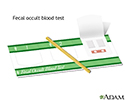Stool guaiac test
Colon cancer - guaiac test; Colorectal cancer - guaiac test; gFOBT; Guaiac smear test; Fecal occult blood test - guaiac smear; Stool occult blood test - guaiac smearThe stool guaiac test looks for hidden (occult) blood in a stool sample. It can find blood even if you cannot see it yourself. It is a common type of fecal occult blood test (FOBT).
Guaiac is a substance from a plant that is used to coat the FOBT test cards to make them able to detect blood.
How the Test is Performed
Usually, you collect a small sample of stool at home. Sometimes, your health care provider may collect a small amount of stool from you during a rectal exam.
If the test is done at home, you will use a test kit. Follow the kit instructions exactly. This ensures accurate results. In brief:
- You collect 2 stool samples from 3 different bowel movements.
- For each bowel movement, you sample 2 areas for each sample, and smear each sample in 1 of 2 places on a card provided in the kit.
- You mail the card to a laboratory for testing.
Be sure to keep the stool away from any urine. Mixing of urine and stool can spoil the sample.
How to Prepare for the Test
Some foods can affect test results. Follow instructions about not eating certain foods before the test. These may include:
- Red meat
- Cantaloupe
- Uncooked broccoli
- Turnip
- Radish
- Horseradish
Some medicines may interfere with the test. These include vitamin C, aspirin, and nonsteroidal anti-inflammatory drugs (NSAIDs) such as ibuprofen and naproxen. Ask your provider if you need to stop taking these before the test. Never stop or change your medicine without first talking to your provider. In particular, high amounts of vitamin C for 3 days before the test could cause a false negative.
How the Test will Feel
The at-home test involves a normal bowel movement. There is no discomfort.
You may have some discomfort if the stool is collected during a rectal exam.
Why the Test is Performed
This test detects blood in the digestive tract. It may be done if:
- You are being screened or tested for colon cancer.
- You have abdominal pain, changes in bowel movements, or weight loss.
- You have anemia (low blood count).
- You say you have blood in the stool or black, tarry stools.
Normal Results
A negative test result means that there is no blood in the stool. Occasionally, this test will miss very small amounts of blood in the stool that is below the level of detection of this test (false negative).
What Abnormal Results Mean
Abnormal results may be due to any problem that causes bleeding in the stomach or intestinal tract, including:
- Swollen, fragile blood vessels in the colon that may result in blood loss
- Colon cancer
- Colon polyps
- Enlarged veins, called varices, in the walls of the esophagus (the tube that connects your throat to your stomach) that bleed
- Inflamed or swollen lining of the stomach or the esophagus
- Infections in the stomach or intestines
- Hemorrhoids
- Crohn disease or ulcerative colitis
- Ulcer in the stomach or first part of the intestines
Other causes of a positive test, which do not indicate a problem in the gastrointestinal tract, include:
- Coughing up and then swallowing blood
- Nose bleed
If the stool guaiac results come back positive for blood in the stool, your provider will likely recommend other tests, often including a colonoscopy.
The stool guaiac test does not diagnose cancer. Screening tests such as colonoscopy can help detect cancer. The stool guaiac test and other screenings can catch colon cancer early, when it is easier to treat.
Risks
There can be false-positive and false-negative results.
Errors are reduced when you follow instructions during collection and avoid certain foods and medicines.
Note that the guaiac test is done less often these days. There is a more sensitive test to detect blood that needs only 1 sample and doesn't need any medication or food adjustments. This test is called FIT testing (fecal immunochemical testing).
References
de Kanter C, Dhaliwal S, Hawks M. Colorectal cancer screening: updated guidelines from the American College of Gastroenterology. Am Fam Physician. 2022;105(3):327-329. PMID: 335289558 pubmed.ncbi.nlm.nih.gov/35289558/.
Lawler M, Johnston B, Van Schaeybroeck S, et al. Colorectal cancer. In: Niederhuber JE, Armitage JO, Kastan MB, Doroshow JH, Tepper JE, eds. Abeloff's Clinical Oncology. 6th ed. Philadelphia, PA: Elsevier; 2020:chap 74.
National Cancer Institute website. Colorectal cancer prevention (PDQ) - health professional version. www.cancer.gov/types/colorectal/hp/colorectal-prevention-pdq. Updated April 11, 2025. Accessed July 11, 2025.
National Comprehensive Cancer Network website. NCCN clinical practice guidelines in oncology (NCCN guidelines): colorectal cancer screening. Version 2.2025 - June 24, 2025. www.nccn.org/professionals/physician_gls/pdf/colorectal_screening.pdf. Updated June 24, 2025. Accessed July 11, 2025.
Patel SG, May FP, Anderson JC, et al. Updates on age to start and stop colorectal cancer screening: recommendations from the U.S. Multi-Society Task Force on colorectal cancer. Gastroenterology. 2022;162(1):285-299. PMID: 34794816 pubmed.ncbi.nlm.nih.gov/34794816/.
Savides TJ, Jensen DM. Gastrointestinal bleeding. In: Feldman M, Friedman LS, Brandt LJ, eds. Sleisenger and Fordtran's Gastrointestinal and Liver Disease. 11th ed. Philadelphia, PA: Elsevier; 2021:chap 20.
US Preventive Services Task Force website. Final recommendation statement. Colorectal cancer: screening. www.uspreventiveservicestaskforce.org/uspstf/recommendation/colorectal-cancer-screening. Published May 18, 2021. Accessed April 2, 2025.










